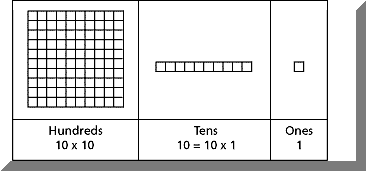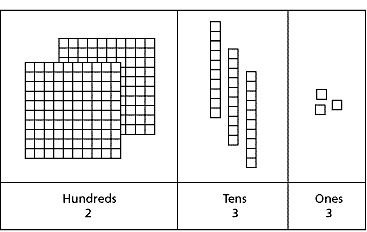
Place value is the basis of our entire number system. A place value system is one in which the position of a digit in a number determines its value. In the standard system, called base ten, each place represents ten times the value of the place to its right. You can think of this as making groups of ten of the smaller unit and combining them to make a new unit.

|
Ten ones make up one of the next larger unit, tens. Ten of those units make up one of the next larger unit, hundreds. This pattern continues for greater values (ten hundreds = one thousand, ten thousands = one ten thousand, etc.), and lesser, decimal values (ten tenths = one one, ten hundredths = one tenth, etc.). At this level, however, your students will be focusing on mastering place value for ones, tens, and hundreds. |

|
In standard form, the number modeled above is 233. |
A place-value chart is a way to make sure digits are in the correct places. A great way to see the place-value relationships in a number is to model the number with actual objects (place-value blocks, bundles of craft sticks, etc.), write the digits in the chart, and then write the number in the usual, or standard form.
Place value is vitally important to all later mathematics. Without it, keeping track of greater numbers rapidly becomes impossible.